Cygnus is a prominent constellation in the northern sky. Its name means “the swan” in Latin and it is also known as the Swan constellation.
Cygnus is associated with the myth of Zeus and Leda in Greek mythology. The constellation is easy to find in the sky as it features a well-known asterism known as the Northern Cross. Cygnus was first catalogued the by Greek astronomer Ptolemy in the 2nd century.
Notable objects in the constellation include Cygnus X-1, a famous x-ray source, the bright stars Deneb and Albireo, the yellow dwarf Kepler-22, which hosts the exoplanet Kepler-22b, the Fireworks Galaxy (NGC 6946), and several well-known nebulae: the Blinking Planetary Nebula (NGC 6826), the Cocoon Nebula (IC 5146), the Jewel Bug Nebula (NGC 7027), the Pelican Nebula (IC 5070), the North America Nebula (NGC 7000), the Crescent Nebula (NGC 6888), Sadr Region (IC 1318) and the Veil Nebula (NGC 6960, 6962, 6979, 6992, and 6995).
Facts, location and map
Cygnus is the 16th largest constellation in the night sky, occupying an area of 804 square degrees. It lies in the fourth quadrant of the northern hemisphere (NQ4) and can be seen at latitudes between +90° and -40°. The neighboring constellations are Cepheus, Draco, Lacerta, Lyra, Pegasus, and Vulpecula.
The constellation name Cygnus is pronounced /ˈsɪɡnəs/. In English, the constellation is known as the Swan. The genitive form of Cygnus, used in star names, is Cygni (pronunciation: /ˈsɪɡnaɪ/). The three-letter abbreviation, adopted by the International Astronomical Union (IAU) in 1922, is Cyg.
Cygnus belongs to the Hercules family of constellations, along with Aquila, Ara, Centaurus, Corona Australis, Corvus, Crater, Crux, Hercules, Hydra, Lupus, Lyra, Ophiuchus, Sagitta, Scutum, Sextans, Serpens, Triangulum Australe, and Vulpecula.
Cygnus has 10 stars with known planets and contains two Messier objects: Messier 29 (NGC 6913) and Messier 39 (NGC 7092). The brightest star in the constellation is Deneb, Alpha Cygni, which is also the 19th brightest star in the sky, with an apparent magnitude of 1.25. There are two meteor showers associated with the constellation: the October Cygnids and the Kappa Cygnids.
Cygnus contains six named stars. The proper names of stars that have been officially approved by the International Astronomical Union (IAU) are Albireo, Aljanah, Azelfafage, Deneb, Fawaris, and Sadr.
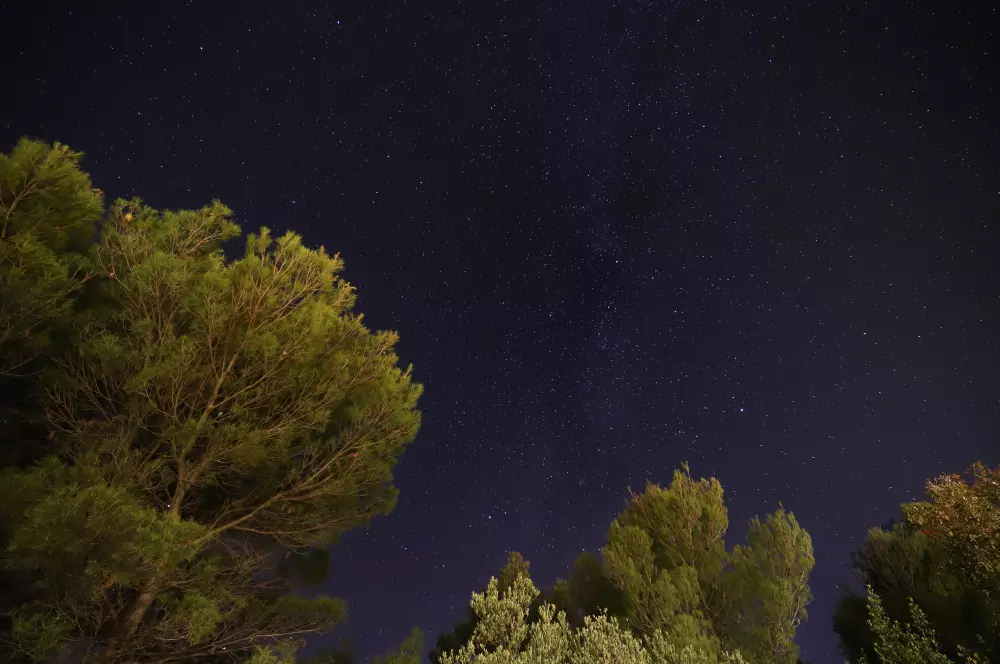
Cygnus, image: Constellation Guide
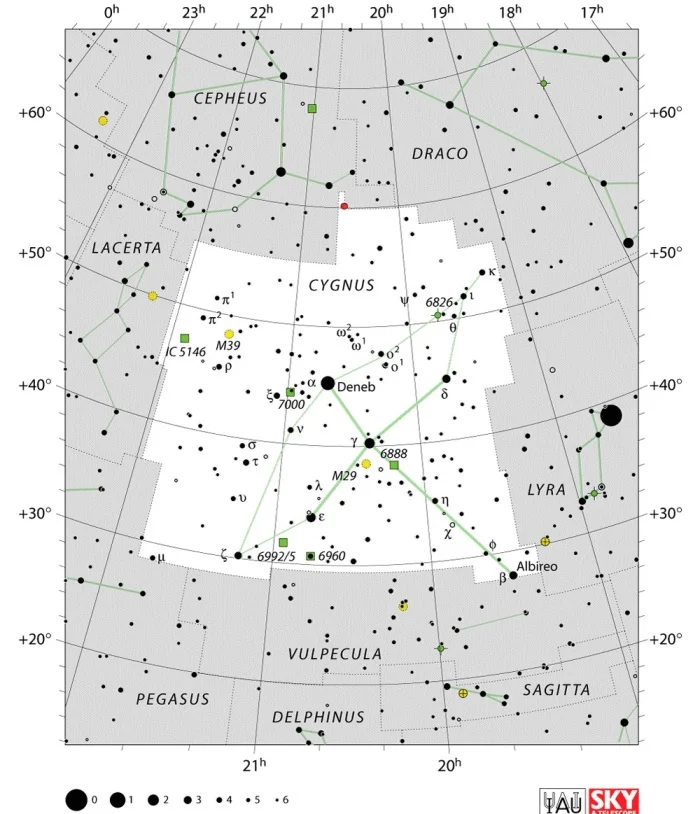
Cygnus constellation map by IAU and Sky&Telescope magazine
Cygnus myth
Cygnus constellation is associated with several myths, most frequently the one of the Spartan Queen Leda, who gave birth to two sets of twins, the immortal Pollux and Helen and mortal Castor and Clytemnestra, after being seduced by the god Zeus, who had transformed himself into a swan. The immortal children were fathered by the god and the mortal ones by Leda’s husband, King Tyndareus. Castor and Pollux are represented by the zodiac constellation Gemini.
Cygnus is also sometimes identified as Orpheus, the Greek tragic hero who met his end at the hands of the Thracian Maenads for not honouring Dionysus. After his passing, Orpheus was transformed into a swan and placed next to his lyre in the sky. The lyre is represented by the neighbouring constellation Lyra.
Cygnus constellation is also sometimes associated with any of the several people called Cycnus in Greek mythology. The most famous ones are Cycnus, the son of Ares who met his end after challenging Hercules to a duel, Cycnus, the son of Poseidon, who fought on the side of the Trojans in the Trojan War, met his end at the hands of Achilles and was transformed into a swan, and Cycnus, a close friend of Phaeton, the mortal son of the Sun god Helios. Of the above three, the myth of Phaeton is the one that is most frequently associated with Cygnus constellation.
In the story, Phaeton and Cycnus were racing each other across the sky when they came too close to the Sun. Their chariots burned up and they fell to the Earth. Cycnus came to and, after looking for Phaeton for a while, he discovered his friend’s body trapped at the bottom of the Eridanus River. He was unable to recover the body, so he made a pact with Zeus: if the god gave him the body of a swan, he would only live as long as a swan usually does. Once transformed, Cycnus was able to dive into the river, retrieve Phaeton’s body and give his friend a proper burial. This allowed Phaeton’s soul to travel to the afterlife. Zeus was moved by Cycnus’ sacrifice and placed his image in the sky.
The Chinese also associate the constellation with a myth, the one of the “magpie bridge,” Que Qiao. In the story, the lovers Niu Lang and Zhi Nu are separated by the Goddess of Heaven because Zhi Nu is a fairy, and is therefore not allowed to be with a mortal man. When the Goddess learns that the two are secretly married, she takes Zhi Nu with her and creates a river in the sky to keep the lovers separated. The river is represented by the Milky Way itself in the legend. Zhi Nu’s husband Niu Lang takes their two children to Heaven so that they can all be together, but the Goddess does not relent and keeps the lovers separated. Once a year, the myth goes, all the magpies in the world assemble to help the lovers be together by forming an enormous bridge over the wide river. The constellation Cygnus represents the magpie bridge in this story.
Asterisms
Northern Cross
The five stars that form the Northern Cross are Deneb (Alpha Cygni), Fawaris (Delta Cygni), Albireo (Beta Cygni), Aljanah (Epsilon Cygni) and Sadr (Gamma Cygni) at the centre.
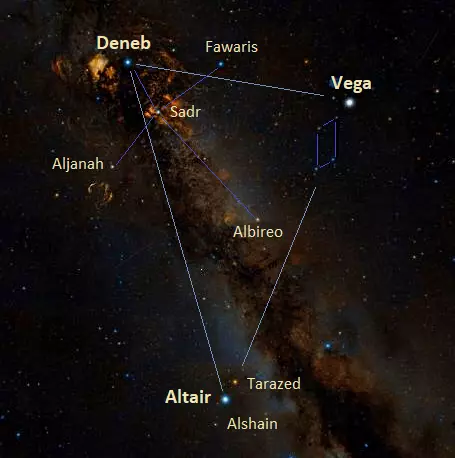
The Summer Triangle and the Northern Cross, image: Wikisky
Cygnus stars
Deneb – α Cygni (Alpha Cygni)
Deneb is a blue-white supergiant belonging to the spectral class A2 Ia, approximately 1,400 light years distant. It is the brightest star in Cygnus and the 19th brightest star in the night sky. It has an apparent magnitude of 1.25. With an absolute magnitude of -7.0, Deneb is one of the most luminous stars known. It is almost 60,000 times more luminous than our Sun and has about 20 solar masses. While it is difficult to get an accurate distance, Deneb is nevertheless the most distant star that shines at first magnitude. It is also one of the largest white stars known. On Mars, Deneb is the North Pole star.
Deneb serves as a prototype for a class of variable stars known as the Alpha Cygni variables. Its brightness and spectral type fluctuate slightly as a result of non-radial fluctuations of the star’s surface. Deneb has stopped fusing hydrogen in its core and is expected to go out as a supernova within the next few million years.
The name Deneb comes from the Arabic dhaneb, meaning “tail,” from the phrase Dhanab ad-Dajājah, which means “the tail of the hen.” In the Chinese myth of the magpie bridge, Deneb marks the bridge or, alternatively, it represents a fairy who chaperones the two lovers when they meet once a year.
Together with the bright stars Altair in the constellation Aquila (the Eagle) and Vega in Lyra, Deneb forms the Summer Triangle, a prominent asterism in the summer sky.
Sadr – γ Cygni (Gamma Cygni)
Gamma Cygni is the star located at the intersection of the Northern Cross. Its traditional name, Sadr, comes from the Arabic word for “the chest,” şadr. It is also sometimes known by its Latin name, Pectus Gallinae, which means “the hen’s chest.”
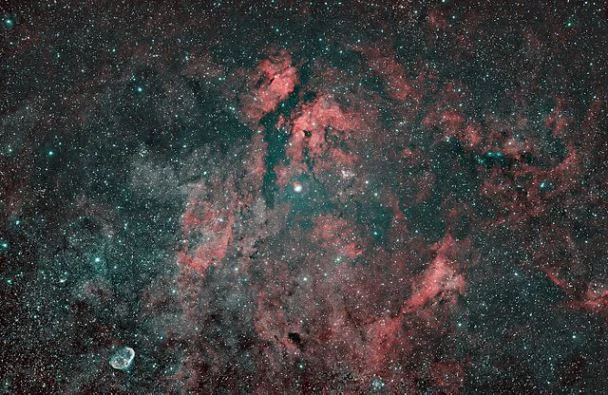
Sadr Region, image: Erik Larsen (CC BY 2.0)
Gamma Cygni belongs to the spectral class F8 lab (indicating that the star is a supergiant) and it is approximately 1,800 light years distant from Earth. It has an apparent magnitude of 2.23 and is one of the brightest stars that can be seen in the night sky. It has twelve solar masses and a radis 150 times solar. Gamma Cygni is believed to be only about 12 million years old. It consumes its nuclear fuel more rapidly because of its mass.
Gamma Cygni is surrounded by a diffuse emission nebula, IC 1318, also known as the Sadr region or the Gamma Cygni region.
Aljanah – ε Cygni (Epsilon Cygni)
Aljanah, Epsilon Cygni, is an orange giant star of the spectral type K0 III. It has an apparent magnitude of 2.480 and is 72.7 light years distant. It is 62 times more luminous than the Sun and has has a radius 11 times solar.
Epsilon Cygni historically shared the traditional name Gienah with Gamma Corvi in the constellation Corvus. However, the International Astronomical Union (IAU) approved the name Aljanah for the star in 2017, while Gamma Corvi has kept the name Gienah. Both names come from the Arabic word janāħ, which means “the wing.” Both stars mark the wings of their respective birds.
Aljanah has a 13th magnitude line-of-sight companion.
Fawaris – δ Cygni (Delta Cygni)
Delta Cygni is a triple star in Cygnus. It will take over as the North Star for at least 400 years around the year 11,250. The star system has a combined apparent magnitude of 2.87 and is approximately 165 light years distant.
The Delta Cygni system consists of two stars lying close together and a star located a bit further from the main pair. The brightest component in the system is a blue-white giant belonging to the spectral class B9 III, which is approaching the final stages of life on the main sequence. It is a fast rotating star, with an equatorial speed of at least 135 kilometres per second.
The star’s closer companion is a yellow-white star belonging to the spectral class F1 V with an apparent magnitude of 6.33. The third component in the Delta Cygni system is a 12th magnitude orange giant.
Albireo – β Cygni (Beta Cygni)
Albireo, Beta Cygni, is only the fifth brightest star in the constellation Cygnus. It is a binary star system that appears as a single third magnitude star to the unaided eye. The system is approximately 380 light years distant.
Albireo marks the head of the swan and is sometimes also known as “the beak star.” It is one of the stars that form the Northern Cross.
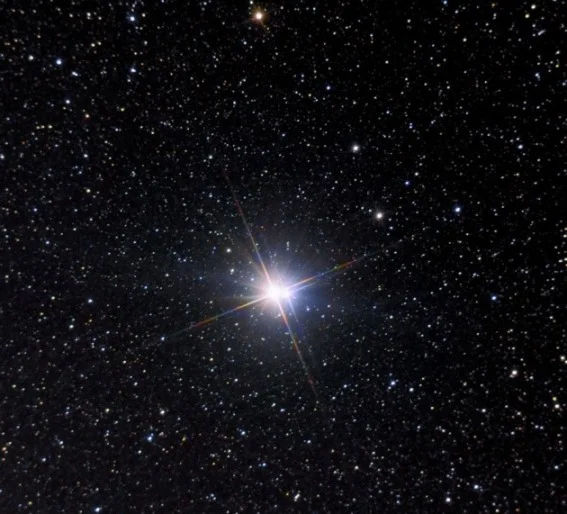
Albireo A, image: Henryk Kowalewski
Albireo is composed of a yellow star with an apparent magnitude of 3.18, which is in fact itself a close binary star, and a fainter blue companion star with an apparent magnitude of 5.82. The components are located 35 arc seconds apart. The contrast between the stars makes Albireo a pretty popular target among amateur astronomers.
Albireo A, the brighter component, consists of two stars only 9.4 arc seconds apart, which cannot be resolved with telescopes less than 20’’ in size. The system belongs to the spectral class K3III.
Albireo B belongs to the spectral type B0V and is a fast-rotating Be star, with an estimated rotational velocity of 250 kilometres per second.
ζ Cygni (Zeta Cygni)
Zeta Cygni is a yellow star belonging to the spectral class G8III, approximately 151 light years distant. It has an apparent magnitude of 3.20. Its radius is 14.7 times solar, and the star is 119 times brighter than the Sun. It is believed to a core-helium fusing giant. The star has a 12th magnitude companion believed to be a white dwarf.
Zeta Cygni and the star CCDM J21129+3014B form a binary system.
τ Cygni (Tau Cygni)
Tau Cygni is a double star in Cygnus. It is composed of a yellowish white subgiant star, GJ 822.1 A, which belongs to the spectral class F2IV, and a sixth magnitude companion, GJ 822.1 B, a yellow main sequence star of the spectral type G0V. The companion has a similar size, luminosity and surface temperature as the Sun.
Tau Cygni’s components have apparent magnitudes of 3.84 and 6.44. The system is 68.2 light years distant from the solar system.
κ Cygni (Kappa Cygni)
Kappa Cygni is a giant star of the spectral type G9 III. It has an apparent magnitude of 3.814 and is 124.2 light years distant from Earth. The star marks the tip of the swan’s left wing. It can be seen without binoculars.
Kappa Cygni is also notable for the meteor shower associated with it. The Kappa Cygnids meteor shower (KCG) can be observed about five degrees north of the star. It is a minor meteor shower that takes place in August every year.
η Cygni (Eta Cygni)
Eta Cygni is an orange giant, belonging to the spectral class K0III, approximately 139 light years distant. It has an apparent magnitude of 3.909.
π Cygni (Pi Cygni)
Pi Cygni consists of two star systems. Pi-1 Cygni belongs to the spectral type B3IV. It has a visual magnitude of 4.67 and is 1680 light years distant. Its traditional name, Azelfafage, comes either from the Arabic phrase al thīlf al faras, which means “the horse track” or from al ʽazal al-dajājah, “the hen’s tail.”
Pi-2 Cygni has a magnitude of 4.23 and is approximately 1156 light years distant. It is a spectroscopic binary star whose main component is a B3-type blue giant, almost 2,200 times more luminous than the Sun.
Pi-2 Cygni has a couple of traditional names: Pennae Caudalis, which means “tail fathers” in Latin, and Sama al Azrak, which is Arabic for “the blue sky.”
Bessel’s Star (Piazzi’s Falling Star) – 61 Cygni
61 Cygni is a double star system composed of a pair of two dwarfs belonging to the spectral types K5V and K7V, which orbit each other every 659 years. They have apparent magnitudes of 5.21 and 6.03 respectively. 61 Cygni is only 11.41 light years distant from the solar system. It is the 15th nearest known star system to Earth.
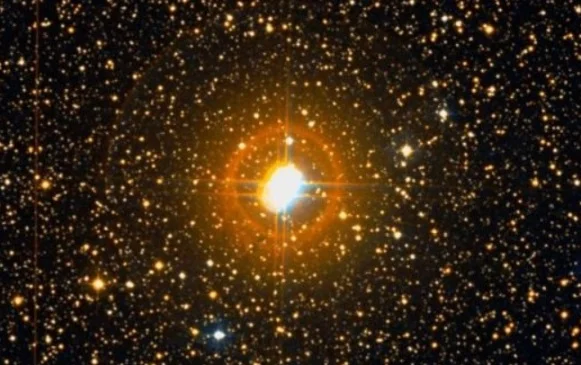
61 Cygni (Bessel’s Star), image: Wikisky
61 Cygni A, the brighter component in the system, is the fourth nearest visible star, after Sirius in Canis Major, Epsilon Eridani in Eridanus, and Procyon A in Canis Minor. It will come within nine light years of the solar system around the year 20,000.
61 Cygni is notable for its large proper motion, the angular change in position over the course of time, as observed from the solar system’s centre of mass. The star’s proper motion was originally demonstrated by the Italian astronomer and mathematician Giuseppe Piazzi in 1804. He named 61 Cygni the Flying Star.
61 Cygni is the first star other than the Sun to have its distance from Earth measured. The German astronomer Friedrich Wilhelm Bessel did this using the method of parallax, measuring the displacement of the star’s apparent position observed along two different lines of sight and the angle of inclination between the two. The star’s large proper motion made it a great candidate for this.
34 Cygni (P Cygni)
P Cygni is a variable star classified as a hypergiant luminous blue variable (LBV). Luminous blue variables are rare and only found in regions of intense star formation. They are usually short lived. Because of their enormous mass and energy, they exhaust their nuclear fuel pretty quickly and erupt into supernovae after only a few million years. Our Sun, for comparison, has been around for several billion years.
P Cygni belongs to the spectral class B1Ia+ and is approximately 6,000 light years distant from Earth. It is one of the most luminous stars ever discovered in the Milky Way.
It was first observed by the Dutch astronomer Willem Janszoon Blaeu in August 1600. It had not been discovered sooner because it only brightened to third magnitude in the last few years of the 16th century. It faded again in 1626 then brightened again in 1655 only to fade again in 1662. The star’s fluctuations in brightness became less dramatic around 1715. It has been a fifth magnitude star ever since. Today, it has an apparent magnitude of 4.8 with fluctuations up to 0.5 magnitudes.
It was Johann Bayer who gave the star the designation P as a nova. P Cygni is sometimes called a permanent nova because of its dramatic changes in brightness, even though the star’s behaviour is not that of a true nova.
39 Cygni
39 Cygni is an orange star belonging to the spectral class K3III. It has an apparent magnitude of 4.436 and is approximately 260 light years distant. It is cooler than the Sun, but much brighter and larger. Its surface temperature is between 3,500 and 5,000 kelvin.
θ Cygni (Theta Cygni)
Theta Cygni is main sequence star belonging to the spectral class F3 V, approximately 59.8 light years distant from the solar system. It has an apparent magnitude of 4.490. It is four times as luminous as our Sun and has about 38 percent more mass. It is between 0.6 and 1.9 billion years old.
The star has a faint companion, one with a magnitude of 13.03, located about three arc seconds away. The companion is a red dwarf belonging to the spectral class M3 V.
Theta Cygni is also notable for possibly having an extrasolar planet in its system. The ELODIE team discovered radial velocity variations that suggest that the star has a planetary object orbiting it with a period of less than six months. The planet is believed to be twice the size of Jupiter, but its presence has not been confirmed yet.
16 Cygni
16 Cygni is a triple star system in Cygnus. The brighter two components, two yellow dwarfs similar to the Sun, have apparent magnitudes of 5.96 and 6.20. The third component is a red dwarf. The system is some 70 light years distant from Earth. An extrasolar planet has been discovered in an eccentric orbit around 16 Cygni B.
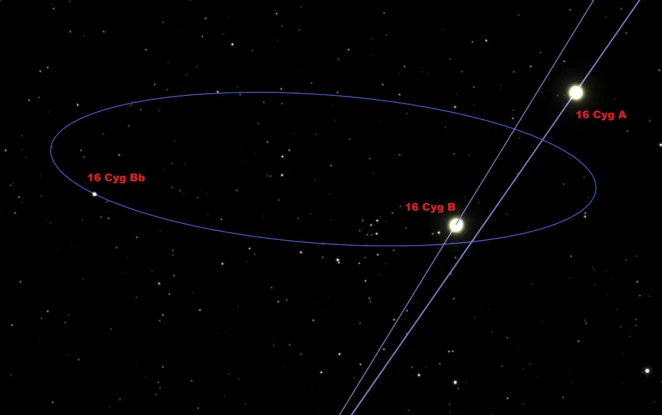
16 Cygni star system and orbits, photo: Arnaugir
Gliese 777
Gliese 777 is a yellow subgiant star belonging to the spectral class G6IV, 51.81 light years distant. It has an apparent magnitude of 5.71. In 2005, two extrasolar planets were confirmed in its system.
The primary star has a companion, a dim red dwarf of the spectral type M4.5V, which is located approximately 3,000 astronomical units away. The red dwarf has a visual magnitude of 14.40 and is a suspected binary star.
Ruchba – ω Cygni (Omega Cygni)
Omega Cygni is a multiple star system in Cygnus. It consists of two visual doubles only a third of a degree apart. The star’s traditional name, Ruchba, comes from the Arabic phrase meaning “the hen’s knee.” Omega-1 Cygni is a hot subgiant belonging to the spectral class B2.5, approximately 910 light years distant. It has a visual magnitude of 4.95. Omega-2 Cygni is a red giant of the spectral type M2III approximately 400 light years from Earth. It has an apparent magnitude of 5.22.
Deep sky objects in Cygnus
Messier 29 (M29) – NGC 6913
Messier 29 is an open cluster with an apparent magnitude of 7.1, approximately 4,000 light years distant. It can be seen with binoculars. The cluster was discovered by Charles Messier in 1764. It lies near the star Gamma Cygni, about 1.7 degrees to the south and a little east.
The estimated age of the cluster is 10 million years. The brightest star has a visual magnitude of 8.59. The five hottest stars in the cluster belong to the spectral class B0.
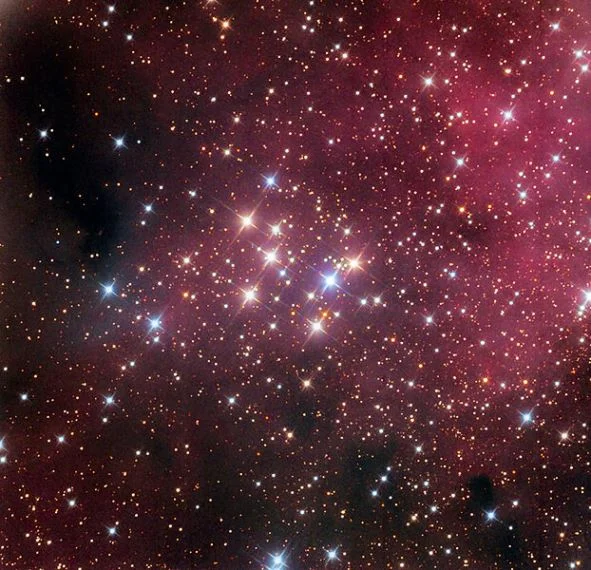
Messier 29, image: Adam Block/Mount Lemmon SkyCenter/University of Arizona (CC BY-SA 3.0 US)
Messier 39 (M39) – NGC 7092
Messier 39 is another open star cluster, also discovered by Charles Messier in 1764. It is between 200 and 300 million years old, which is an intermediate age for an open cluster. The cluster is located about 800 light years from the solar system.
M39 has an apparent magnitude of 5.5. The brightest star belongs to the spectral class A0 and has a visual magnitude of 6.83. All the stars observed in the cluster are on the main sequence, and the brightest ones will soon evolve to the red giant stage.
The cluster can be found two and a half degrees west and a degree south of the star Pi-2 Cygni.
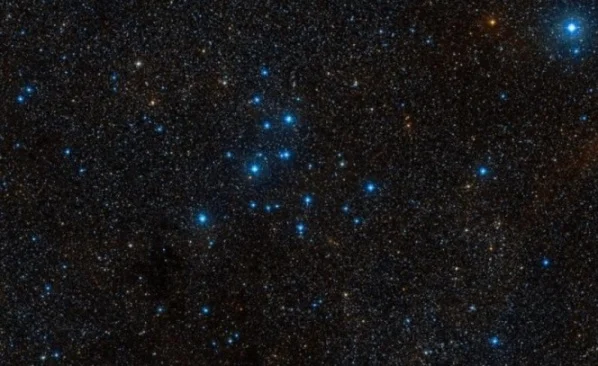
Messier 39, image: Wikisky
Fireworks Galaxy – NGC 6946 (Arp 29)
The Fireworks Galaxy (NGC 6946) is an intermediate spiral galaxy in Cygnus. It has an apparent magnitude of 9.6 and is approximately 22.5 million light years distant.
The galaxy is located near the border with the constellation Cepheus. It lies close to the galactic plane and is very obscured by interstellar matter of the Milky Way.
NGC 6946 was discovered by the German-born British astronomer Sir Frederick William Herschel on September 9, 1798. Nine supernovae have been observed in the galaxy since: SN 1917A, SN 1939C, SN 1948B, SN 1968D, SN 1969P, SN 1980K, SN 2002hh, SN 2004et and SN 2008S.
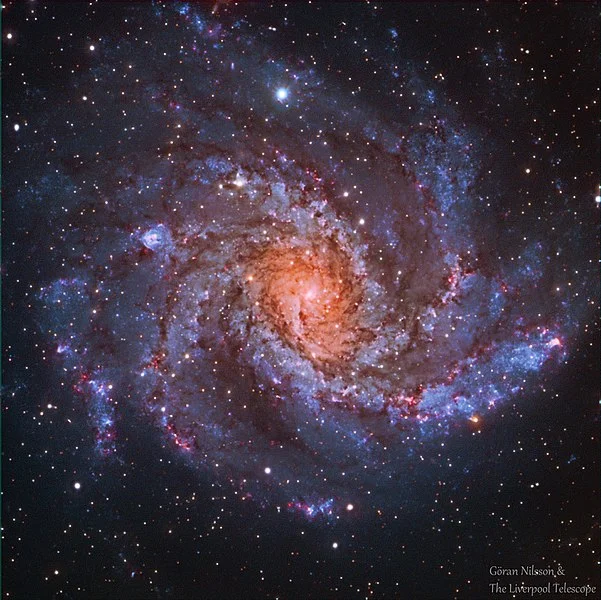
The Fireworks Galaxy (NGC 6946), image: Göran Nilsson & The Liverpool Telescope (CC BY-SA 4.0)
Cygnus X-1
Cygnus X-1 is a famous X-ray source, one of the strongest ones seen from Earth. It was first discovered in 1964 during a rocket flight.
Cygnus X-1 is notable for being the first X-ray source widely believed to be a black hole candidate; it has a mass 8.7 times that of the Sun, yet it is too compact to be any kind of known object other than a black hole. It is approximately 6,100 light years distant from Earth.
Cygnus X-1 orbits a blue supergiant variable star, HDE 226868, and the two stars form a binary system. Over time, an accretion disk of material brought from the star by a stellar wind has formed around Cygnus X-1.
North America Nebula – NGC 7000 (Caldwell 20)
NGC 7000 in Cygnus was named the North America Nebula because its shape strongly resembles that of the continent. The nebula is obscured by a band of dust, which determines its shape as we see it.
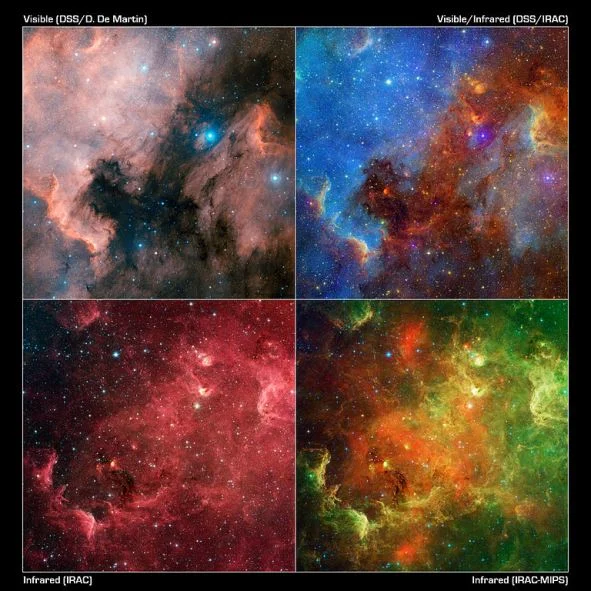
The North America Nebula and the Pelican Nebula — This layout of images reveals how the appearance of the North America nebula can change dramatically using different combinations of visible and infrared observations from the Digitized Sky Survey and NASA’s Spitzer Space Telescope, respectively. In this progression, the visible-light view (upper left) shows a striking similarity to the North America continent. Each is cropped to the easterly bulk (thus also the quasi-“Gulf of Mexico” region). The red region to the right is known as the “Pelican nebula,” after its resemblance in visible light to a pelican. The view at upper right includes both visible and infrared observations. The hot gas comprising the North America continent and the Pelican now takes on a vivid blue hue, while red colours display the infrared light. Inky black dust features start to glow in the infrared view. In the bottom two images, only infrared light from Spitzer is shown — data from the infrared array camera is on the left, and data from both the infrared array camera and the multi-band imaging photometer, which sees longer wavelengths, is on the right. These pictures look different in part because infrared light can penetrate dust whereas visible light cannot. Dusty, dark clouds in the visible image become transparent in Spitzer’s view. In addition, Spitzer’s infrared detectors pick up the glow of dusty cocoons enveloping baby stars. Image: NASA/JPL-Caltech/L. Rebull (SSC/Caltech)
The North America Nebula is an emission nebula. It has an apparent magnitude of 4 and is approximately 1,600 light years distant from Earth.
The North America Nebula is very large, about 120 by 100 arc minutes, but it usually cannot be seen without binoculars because its surface brightness is pretty low. It was discovered by William Herschel on October 24, 1786.
The greatest concentration of star forming activity occurs in the region called the Cygnus Wall, which is the part of the nebula that corresponds to the Mexico and Central America region (so to speak).
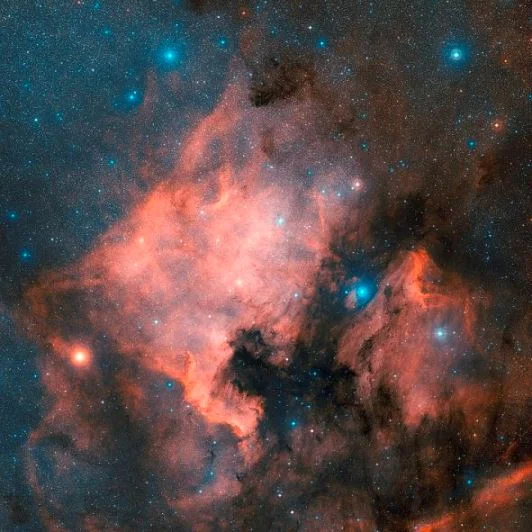
The North America Nebula and the Pelican Nebula, image: NASA
NGC 7000 is a part of the same H II region (interstellar cloud in which stars are formed) as the neighbouring Pelican Nebula (IC 5070).
Pelican Nebula – IC 5070 and IC 5067
The Pelican Nebula is an emission nebula in Cygnus. It has an apparent magnitude of 8.0 and is approximately 1,800 light years distant from Earth. It got its name because its shape resembles that of the pelican.
The nebula is an H II region, a large gas cloud in which star forming activity takes place and newly formed blue stars emit ultraviolet light which ionizes the gas in the cloud.
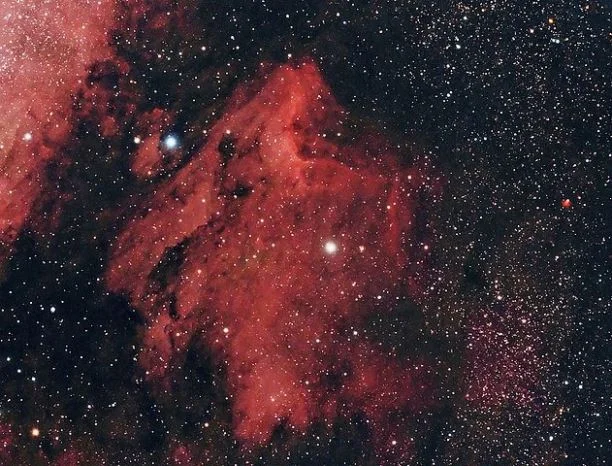
Pelican Nebula, image: Wikimedia Commons/Hewholooks
The nebula is associated with the nearby North America Nebula and is separated from it by a large molecular cloud filled with dark dust. The two nebulae are about 1,500 light years apart.
The Pelican Nebula is located near the bright star Deneb and can be found to the northeast of the star.
Sadr Region – IC 1318
IC 1318 is an emission nebula formed around the star Sadr, Gamma Cygni, located at the intersection of the Northern Cross in Cygnus.
Crescent Nebula – NGC 6888 (Caldwell 27, Sharpless 105)
The Crescent Nebula is an emission nebula formed by the strong stellar wind of HD 192163 (WR 136), which is a Wolf Rayet star in Cygnus. A Wolf Rayet star is a hot, old, massive star that is rapidly losing mass by means of a fast stellar wind.
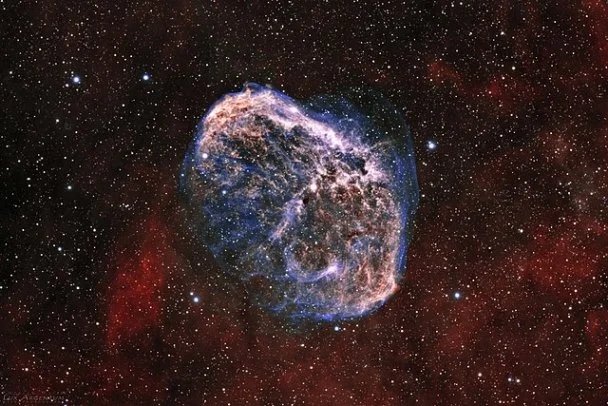
An image of the emission nebula NGC 6888, also known as the Crescent Nebula, in the constellation Cygnus. This object is approximately 5000 light years distant and 26 light years in diameter and is formed by high velocity stellar wind from the central star WR 136 colliding with gas previously shed from the star. This object was imaged in hydrogen-alpha and oxygen-III emission lines; red colors are hydrogen, and blue oxygen. Image: Patrick Hsieh (CC BY-SA 4.0)
The shell is a result of the stellar wind from the star colliding with the wind that the star ejected when it evolved into a red giant some 400,000 years ago.
The nebula is 18’x12’ in size, has an apparent magnitude of 7.4, and is approximately 5,000 light years distant.
Cygnus Loop (Sharpless 103)
The Cygnus Loop is a large supernova remnant, almost three degrees across in the sky, forming an emission nebula in Cygnus. It is a strong source of soft X-rays.
The arcs of the loop that emit in visible light are known as the Veil Nebula and the rest of the loop can be detected in radio, infrared and X-ray images.
Veil Nebula – NGC 6960, NGC 6992, NGC 6995, NGC 6974, NGC 6979 (IC 1340)
The Veil Nebula is the visual component of the Cygnus Loop. Also known as the Cirrus Nebula or Filamentary Nebula, it consists of several components: the Western Veil (NGC 6960), the Eastern Veil (NGC 6992, NGC 6995, IC 1340), and Fleming’s Triangle (Pickering’s Triangle).
NGC 6960, the Western Veil, is sometimes also called the Witch’s Broom. It forms the western-most part of the nebula. The Eastern Veil consists of three bright regions – NGC 6996, NGC 6995 and IC 1340.
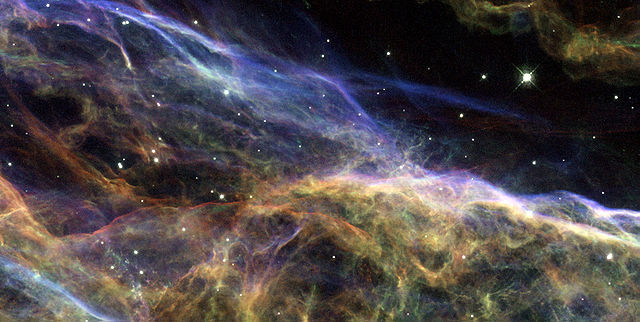
Portion of the Veil Nebula as photographed by the Hubble Space Telescope. Image: NASA, ESA, and the Hubble Heritage (STScI/AURA)-ESA/Hubble Collaboration
Pickering’s Triangle, also known as Pickering’s Wedge or Pickering’s Triangular Wisp, is a faint region of nebulosity discovered by the American astronomer Williamina Fleming in 1904. It was named after Edward Charles Pickering, the director of the Harvard Observatory, where Fleming made the discovery.
NGC 6974 and NGC 6979 are also regions of nebulosity located in a cloud at the northern edge of the nebula. NGC 6979 was discovered by William Herschel, and NGC 6974 by Lord Rosse, a British astronomer.
The Cygnus Loop is about 90 light years in size and approximately 1470 light years distant from Earth. The estimated age of the supernova remnant is between 5,000 and 8,000 years.